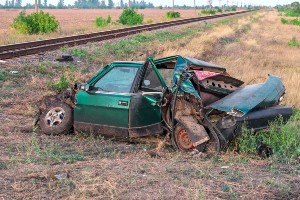
There is a need for safer railroad crossings. On Tuesday, February 7, 2023, Pleasant Hill, Missouri was the sight of a deadly railroad crossing accident. A collision between a delivery truck and an Amtrak train resulted in the truck driver’s death. The accident happened on uncontrolled tracks, which means that only simple stop signs are posted on either side of the crossing.
Deadly Missouri Train Derailment (June, 2022)
According to the Federal Railroad Administration (FRA), 94% of all rail-related fatalities and injuries occur at railroad crossings or due to trespassing. Railroad crossing incidents are the second leading cause of rail-related deaths in America.
Per the NHTSA, in 2021, there were more than 1,600 collisions between vehicles and freight and commuter trains and nearly 500 collisions at transit train crossings in 2020. The result: 133 people died and 644 injured.
 Despite a driver’s best efforts, railroad accidents happen for many reasons. Most are at passive crossings (without gates and lights) and have trees or vegetation blocking the views down the tracks; however, common causes of railroad crossing accidents include:
Despite a driver’s best efforts, railroad accidents happen for many reasons. Most are at passive crossings (without gates and lights) and have trees or vegetation blocking the views down the tracks; however, common causes of railroad crossing accidents include:
A freight train traveling 55 mph needs over a mile or more to stop. In most instances, a train cannot stop in time to avoid an accident.
Most railroads are privately owned and publicly funded. Federal, state, and local governments and private owners share the burden of maintaining and keeping railroad crossings safe.
Questions? Call us at (877) 284-6600 for a free, no-obligation care review.
Whether or not there are active crossing warnings, drivers should take steps to cross safely.
Missouri’s rail network is owned and maintained by 22 rail carriers operating 4,362 miles of rail network within the State. These rail carriers range from large Class I railroads, which operate extensive national and international rail systems, to small switching and terminal railroads, which provide vital rail support functions.
The 5300 miles of track in Missouri vary in its ability to meet modern demand. Corridors range from barely traveled to above capacity. This produces a need for targeted rail investments, particularly those which improve the safety of the network.
Source: Missouri’s State Freight & Rail Plan
Having an attorney who is your advocate can offer you peace of mind during your recovery.
Take advantage of our experience. We have a successful track record of helping accident victims collect the compensation they deserve. If you or a loved one has been seriously injured in a train railroad crossing accident, call the Kansas City-based law firm of Nash & Franciskato at (877) 284-6600.
One of our experienced staff will speak with you personally and will provide you with a free, no-obligation case evaluation.
START YOUR FREE CASE EVALUATION TODAY
If you would like to receive news and blog updates on a regular basis, sign up to receive our email newsletter. Your email address will only be used to send you our newsletter and respond to inquiries.
Past results afford no guarantee of future results and each case is different and is judged on its own merits. The choice of a lawyer is an important decision and should not be based solely on advertisements.
Photos are not of the actual accident.